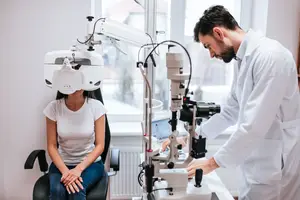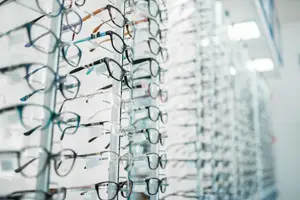Prescription eyeglasses at Bettner Vision are designed to support clear, comfortable vision for everyday life. With a large in-office boutique and an on-site optical lab, your prescription is handled from exam to finished lenses within the same practice.
Prescription Eyeglasses in Colorado Springs

Signs You May Need New Eyewear
Most people benefit from updating their glasses every 1 to 2 years, but the timing depends on how their eyes change and how their glasses are holding up. You might need new eyewear sooner if you experience symptoms such as headaches, eyestrain, or blurred vision, or if your frames or lenses become damaged or uncomfortable. Children, teens, and patients with medical eye conditions often require more frequent updates to support clear, comfortable vision for school, work, and daily tasks.
From Eye Exam to Precise Prescription
If part of your prescription reads “plano,” it simply means that the eye does not need corrective power at that distance.
Your prescription may also include terms such as OD and OS (right and left eye), SPH for the amount of nearsightedness or farsightedness, CYL and Axis for astigmatism correction, ADD for near-vision support in bifocal or progressive lenses, PD for the distance between your pupils, and Prism for aligning images in cases of double vision.
These measurements help ensure your lenses are made accurately and match your visual needs.


Browse Our Frame Selection at Bettner Vision Boutique
The Bettner Vision Boutique offers a wide selection of prescription-ready frames for children and adults. The optical team assists patients in choosing frames that align with their prescription needs and day-to-day use, whether glasses are worn full-time or for specific tasks such as school, work, or reading.
Patients can see and try on options in person, allowing adjustments before lenses are edged and mounted in the on-site lab.
Prescription Eyewear for Active Lifestyles
For patients who need prescription eyewear for sports or active use, Bettner Vision carries Rec Specs and additional sports-focused frames. These options can be ordered with prescription lenses from the on-site lab, providing both clarity and impact protection appropriate for athletic settings.
Families with school-age children and active adults can explore these options as part of their prescription eyewear planning.


The Impact of Wearing Outdated Glasses
Wearing an outdated prescription won’t damage your eyes, but it can lead to headaches, eyestrain, and difficulty seeing clearly, especially when driving, working, or reading.
These symptoms often signal that your vision needs have changed. Updating your prescription during a comprehensive eye exam helps maintain comfortable, reliable vision throughout daily tasks.
How to Tell If Your Glasses Are Too Strong
Glasses that feel too strong can cause symptoms such as eye strain, headaches, dizziness, or difficulty focusing, especially when shifting between distances.
These signs don’t mean your eyes are harmed, but they may indicate that your prescription no longer matches your visual needs.
A comprehensive eye exam is the best way to determine whether your current glasses are appropriate or if an adjustment is needed for clearer, more comfortable vision.

Ongoing Support for Your Glasses from Our Bettner Vision Opticians
After you receive your prescription eyeglasses, Bettner Vision offers adjustments and routine fit checks to help maintain proper alignment and comfort. If you notice changes in how your glasses sit or how they feel, you can return to the optical for assistance.
